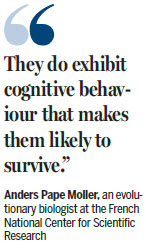Birds hit by cars are birdbrained
PARIS - What's the difference between birds that get killed by cars, and those that don't?
The dead ones tend to have smaller brains, scientists who performed 3,521 avian autopsies said on Wednesday.
What might be called the "bird brain rule" applies to different species, depending on the ratio of gray matter to body mass, they reported in the journal Royal Society Open Science.
Crows, for example, have big brains relative to their size, and have shown a remarkable knack for navigating oncoming traffic.
While picking at road kill on Florida highways, earlier research showed, the scavengers learned to ignore cars and trucks whizzing by them within inches, but would fly away just in time when threatened by a vehicle in their lane.

"I don't know if we can say they are 'smarter', but they do exhibit cognitive behavior that makes them likely to survive," said lead author Anders Pape Moller, an evolutionary biologist at the French National Center for Scientific Research.
Pigeons, by contrast, appear to be less adept at avoiding collisions, a deficiency visible in compressed form on most big-city streets. Not coincidentally, they have teeny-weeny brains.
More surprisingly, the relation between brain size and traffic accidents also holds within the same species, the study found.
"Common European blackbirds, house sparrows and robins all show this difference in individuals that were hit by cars, and those that were not," Moller said.
Undamaged brains from birds killed in accidents - weighed to within a hundredth of a gram - were consistently smaller, he said.
At the same time, other organs - liver, heart and lungs - all had the same mass. The researchers examined 251 different species.
Recent research has shown that evolutionary changes in many animals - fish and insects, in particular - are occurring in response to climate change and human encroachment on habitat far more quickly that scientists imagined possible.
The State of the Birds annual report estimated in 2014 that 200 million birds perish on the road every year in the United States alone.
Estimates for Europe are lower, but worldwide the grim tally is certainly in the hundreds of millions.
But there are an estimated 300 billion birds in the world, so the death toll is still only a fraction of 1 percent.
There is one threat, however, to which our feathered friends almost certainly have evolved to avoid, though with limited success.
The same report estimates that 2.4 billion birds fall victim in cats every year in the US.
(China Daily 03/31/2017 page11)














